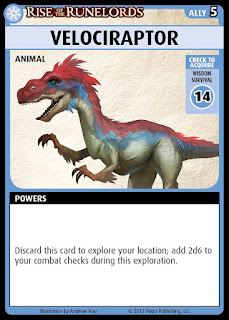(Image comes from
the Paizo blog and is © Paizo Publishing.)
A star of dinosaur
picture books for its horned frill, the styracosaurus in the Pathfinder game
uses those horns in a devastating defense (up to five attacks of opportunity in
a single round). Meanwhile, the movie
star velociraptor gets cut down to its paleontologically accurate size—only
one-and-a-half feet tall—but with sickle-like claws and coordinated pack
hunting, that’s still deadly enough when facing novice adventurers,
particularly those who have never seen a dinosaur before.
Orcs love “spearshields”—their word for styracosauruses.
They goad their beasts into wherever the fighting is thickest, where the
dinosaurs’ thrashing can have the most devastating effect. Orcs paint the frills of their beasts in
tribal colors, and knowledgeable adventurers can use this to figure out which
tribe is currently in charge—or even to sneak through orc lands themselves, if
they have a styracosaurus companion they can paint.
Velociraptors are a constant hazard in the Oni’s Tears, an archipelago favored
by pirates, smugglers, spice merchants, and drug runners (the last two often
being one and the same). More than one
ghost ship has turned out to be the result of a pack of velociraptors sneaking
aboard and eviscerating the crew.
Drought has struck the White Eagle Desert for the third year in a row. Now even traditionally healthy rivers are
drying up. To the rock gnome village of
Mollawud, this means they are no longer protected on three sides by water. The gnomes need help defending their homes
and fields against the velociraptors that are now free to strike at them day
and night. If the adventurers instead
try to help the gnomes move, they must defend them along the way against heat
exhaustion, fire wolves, thylacines, bunyips, and their fever gnome kin.
—Pathfinder Bestiary 4 59
I got several nice private notes from people reacting to
this answer I posted two weekends back, and among the lines in one of them was
the following:
I’d
love for you to continue, as your posts are always fantastic inspiration for my
own game, but it sounds like you’re getting a bit burned out.
To which my response was, “Oh noes! Everyone thinks I’m burned out!”
If you read the other weekend’s post and thought that’s what
I was saying, that’s my bad for leading you astray. I am definitely *not* burned out on The Daily Bestiary—not at all; I could
keep this up forever. There’s just also
all this other stuff I want to do too, and only 24 hours in a day. It’s not a question of being burned out; it's
a question of “How do I deliver the most awesome content I can and have fun
doing it?” Ideally I can do The Daily Bestiary *and* all that other
stuff, but I also have to pay a mortgage and occasionally sleep, too. So I’m just trying to figure out how to
juggle all of that and still serve up the best entertainment I can, in whatever
form it takes.
Which, by the way,
is why you shouldn’t panic if I take chunks of the next two weeks off. I’m hitting crunch time on several work
projects and already know I’m working through the next two weekends. (So instead of looking forward to a day off
tomorrow, I’m looking forward to Day Six of a 19-day week—on the last two
weekends of summer, to add insult to injury…and guess who had travel plans he
had to cancel. Sigh.) We should
be finishing up Bestiary 4 in the
next two weeks, but since I can't guarantee I’ll have enough juice to post,
I’ll instead use the time to catch up on some reader mail and otherwise work on
my backlog.


